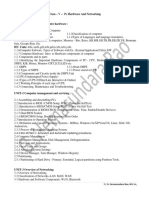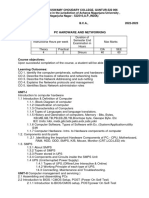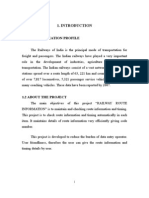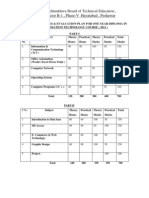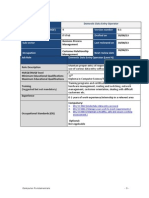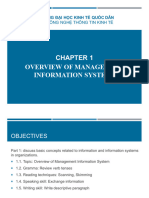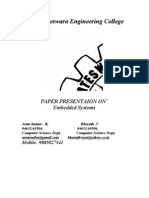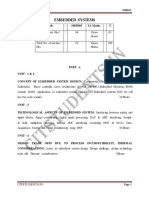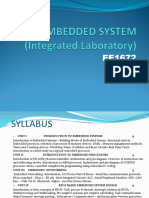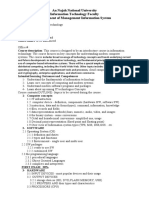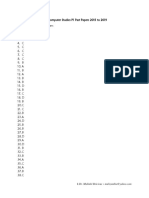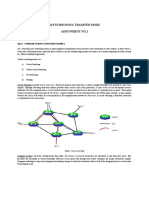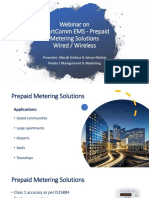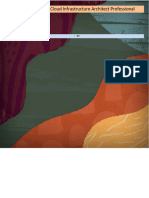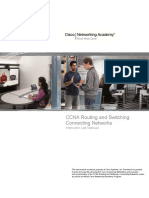IT - Informatics Alphabet
IT - Informatics Alphabet
Uploaded by
Drago RadićCopyright:
Available Formats
IT - Informatics Alphabet
IT - Informatics Alphabet
Uploaded by
Drago RadićCopyright
Available Formats
Share this document
Did you find this document useful?
Is this content inappropriate?
Copyright:
Available Formats
IT - Informatics Alphabet
IT - Informatics Alphabet
Uploaded by
Drago RadićCopyright:
Available Formats
IT - Informatics Alphabet
At the present time in everyday life is all pervasive use of the term INFORMATION and INFORMATICS science, and that often is not clear what the two terms mean. Briefly, the information notice, statement or information that increases knowledge about solving the tasks set, and informatics is the science of exploiting information regarding the management and decision-making in business, science, technology, economics, and all other human activities. IT is increasingly becoming an introduction to the effectiveness of human creativity, and a e-Book 'IT - Informatics Alphabet' is precisely in this sense, is designed as an overview of everything that preceded the use of IT skills for successful processing and use information. E-Book content displayed onwards; names are also links to individual pages:
Preface Introduction 1. BASIC IT TERMS 1.1. CONCEPT OF INFORMATICS 1.2. AMOUNT OF INFORMATION 1.3. THEORY OF SIGNAL 2. ELEMENTS OF DIGITAL COMPUTING SYSTEMS (DCS) 2.1. NUMBER SYSTEMS 2.1.1. Decade number system 2.1.2. Binary number system 2.1.3. Octal number system 2.1.4. Hexadecimal number system 2.2. CODE AND CODING 2.2.1. BCD code 2.2.2. ASCII code 2.2.3. Other codes 2.2.4. Unicode 2.3. COMPUTER ARITHMETIC 2.3.1. Binary arithmetic 2.3.2. II Complement 2.4. COMPUTER LOGIC 2.4.1. Logic of Sets 2.4.2. Basic Computer Logic Circuits 3. ORGANIZATION AND STRUCTURE OF THE DCS 3.1. DEFINITION OF DCS 3.2. HISTORIC DEVELOPMENT OF DCS 3.3. COMPUTER HARDWARE 3.3.1. C P U (Microprocessor) 3.3.2. Organization of a Computer System 3.3.3. Address Field of the Computer (Map) 3.3.4. Execution of Instructions
3.3.5. Working (main) Memory 3.3.6. Permanent Memory SCSI, SAS, SATA - RAID Optical devices and Drives USB stick 3.3.7. I / O Ports and Peripherals 3.3.8. Inputs and Outputs of Computer Equipment Computer Monitor Computer Printer Keyboard and Mouse, Computer ChipSet 3.3.9. Power Source - SPS Uninterruptible Power Supply - UPS 3.4. COMPUTER SOFTWARE 3.4.1. Operating System 3.4.2. Language Processors (Compilers) Programs for Programming 3.4.3. Customer aid Software 3.5. PC COMPUTER SYSTEM 3.5.1. Organization and Structure 3.5.2. Microprocessor - BUS DMA - Direct Memory Access 3.5.3. Working (main) Memory Addressing Memory 3.5.4. Permanent Memory 3.5.5. Programmable Counters, Interruptions (IRQ) 3.5.6. Graphics System Color Correction of Monitor 3.5.7. Keyboard, Mouse 3.5.8. Peripherals 3.5.9. Motherboard PCI-Express Motherboard - Chipset X79 PCI-Express Motherboard - Chipset Z77 PCI-Express Motherboard - Chipset Z87 PCI-Express Motherboard - Chipset NM10 3.5.10. Computer Casing 3.5.11. Accessibility of PC Systems 3.6. COMPUTER NETWORKS Network subsystems 3.6.1. Network Topology 3.6.2. Protocols - OSI Model 3.6.3. PC in the network Configuring the PC Network Organization of the Network System Network System NETWARE 3.6.4. Network Interface Card (NIC)
UTP, STP communication cable Optical communication cable 3.6.5. Modem 3.6.6. ISDN, ADSL 4. MICROSOFT WINDOWS OPERATING SYSTEMS 4.1. MS-DOS Operating System 4.1.1. File and its specification 4.1.2. View the content of disk, directory and file 4.1.3. Copy, move and delete 4.1.4. Commands of System 4.2. MS-WINDOWS 3.11 Graphical User Interface (GUI) 4.2.1. Program group MAIN 4.2.2. File Manager 4.3. WINDOWS 95, 98 Operating System START menu 4.3.1. Desktop 4.3.2. Windows Explorer (WE) 4.3.3. Control Panel 4.3.4. Computer Networking Adjusting TCP / IP network settings 4.3.5. Connecting to Windows XP Operating System 4.4. WINDOWS XP Operating System START menu 4.4.1. General features of OS 4.4.2. Structure of OS Users of the system System Policy Computer Devices 4.4.3. Adjusting regional settings Adjust the display and performance Adjusting environment variables Relocation of working maps 4.4.4. Windows XP in the network TCP / IP network settings Wireless networking System protection - Firewall 4.4.5. Registry 4.4.6. Protection of data (backup) Symantec Norton GHOST System Restore 4.4.7. System Junctions and Links 4.4.8. System Supervision 4.4.9. RAM-Disk 4.5. WINDOWS 7 Operating System
START menu Initial installation of OS Complete installation of OS Basic adjustment of OS 4.5.1. General features of OS 4.5.2. Structure of OS Users and Devices 4.5.3. System adjustment System and Security General settings of the System Network Connection Devices and Hardware Software and Gadgets User Account, Parental Control and CardSpace Displaying and Personality START menu, maps, and files Regional and Language settings Ease of Access and Speech Recognition Other settings of System and Software 4.5.4. Relocation of working maps 4.5.5. Windows 7 in the network - TCP / IP settings Availability of resources (Sharing) Wireless networking 4.5.6. System protection - Firewall 4.5.7. XP Mode 5. UNIX OPERATING SYSTEMS 5.1. LINUX - DEBIAN Operating System Initial installation of OS Complete installation of OS 5.1.1. General features of Debian OS 5.1.2. File System Model 5.1.3. Structure of File System; root, boot, bin, lib, dev File System; etc, mnt, proc, tmp File System; home, usr, var 5.1.4. Basic operating system commands Rest of OS commands 5.1.5. Command interpreter (shell) - scripts 5.1.6. Maintaining the Operating System 5.1.7. X Window graphics subsystem 5.2. LINUX - UBUNTU operating System 6. SOFTWARE DEVELOPMENT 6.1. PHASES OF SOFTWARE PEVELOPMENT Example of the initial stages of software development
6.1.1. Guessing a random number 6.1.2. System of linear equations 6.1.3. Surface of trigonometric figures 6.1.4. Flow of trigonometric functions 6.1.5. Sorting by the length of the text 6.1.6. Range of oblique shot 6.2. PROGRAMMING 6.2.1. QBASIC programming tool 6.2.2. Possibilities of QBASIC 6.2.3. Programming in QBASIC 6.2.4. Algorithm, flowchart and program code 6.2.5. Programming in QBASIC by Chapters 6.1.X 7. INFORMATICS IN PRACTICE 7.1. A/D - D/A CONVERTERS 7.1.1. A/D Converter Characteristics of A/D converters Converters in Measurement - Sensors 7.1.2. D/A Converter Characteristics of D/A converters 7.2. MICROCONTROLLER Programming Microcontrollers 7.3. COMPUTERS AND PROCESSES Display output Data 7.3.1. On-line systems Improving the system with Open Loop Auxiliary functions 7.3.2. Computer operating aids The role and use of work aids Examples of computer work aids 7.4. INTERNET Principles of Internet working, OSI - TCP / IP model 7.4.1. Services of Internet 7.4.2. TCP, UDP Port - Socket 7.4.3. TCP / IP protocol Stack Access to a network media - MAC address 7.4.4. Network Devices Ethernet network card (NIC) 7.4.5. DNS - DHCP service 7.5. INTRANET 7.5.1. Structured cabling 7.5.2. Wireless communication 7.5.3. Proxy server 7.6. SOHO - Thomson Gateway ST780i WL 7.6.1. Basic Configuration (management)
7.6.2. Settings for Programs (Software) 7.7. EARNING ON THE INTERNET 7.7.1. Google Webmaster Tools, Google Analytics 7.7.2. Google AdSense, Google AdWords 7.8. pH METER 7.9. C4ISR 7.10. FORMULA 1 (F1) 7.11. ELECTRIC CAR 8. GLOSSARY OF IT TERMS | No | A | B | C | D | E | F | G | H | I | J | K | L | M | N | | O | P | Q | R | S | T | U | V | W | X,Y | Z | @,#,$ | Specific IT Concepts Chip - Integrated Circuit Computer & network protocols; TCP / IP - OSI model DVB - Digital Video Broadcasting - Digital TV Encrypting - GnuPG ( GNU Privacy Guard ) Grounding of electronic devices - GND (ground) IOS CLI commands - Classes of networks, subnetting Mobile devices - phone, smartphone, tablet Multimedia - Home Theater Multimedia, program support (software) - Media Player Network equipment - Patch cabinet (rack) Syntax - rules of use commands and editing documents Virtual Computer - Microsoft Virtual PC 2007 9. APPENDIX - CODE PAGES a.) 437 ( DOS ) Latin US - code page b.) 850 ( DOS-CROSCII ) Latin I - code page c.) 852 ( DOS ) Latin II - code page ( HR ) d.) 1252 ( MS Windows ) Latin 1 - code page e.) 1250 ( MS Windows ) Latin 2 - code page ( HR ) f.) 8859-2 ( ISO) Latin 2 - code page ( HR ) g.) 1250 Latin Extended ( Unicode ) - code page ( HR ) h.) Most important keyboard shortcuts i.) Instruction for installation of Software 10. BIBLIOGRAPHY 11. WEB LINKS 12. INDEX
You might also like
- Computer Fundamentals Architecture and OrganizationDocument450 pagesComputer Fundamentals Architecture and OrganizationKasraSr89% (18)
- CoDeSys SP 32 Bit Embedded - EDocument70 pagesCoDeSys SP 32 Bit Embedded - EKamalakannan Karuppiah100% (1)
- Serial Port Complete: COM Ports, USB Virtual COM Ports, and Ports for Embedded SystemsFrom EverandSerial Port Complete: COM Ports, USB Virtual COM Ports, and Ports for Embedded SystemsRating: 3.5 out of 5 stars3.5/5 (9)
- Myhotspot, Billing Hotspot 2013 Gratis Dan Dapat Sepenuhnya DigunakanDocument10 pagesMyhotspot, Billing Hotspot 2013 Gratis Dan Dapat Sepenuhnya DigunakanAy SusantoNo ratings yet
- Case StudyDocument7 pagesCase StudyDaniel S. NavaNo ratings yet
- Computer Hardware and Maintenance (9089)Document7 pagesComputer Hardware and Maintenance (9089)Suman Ghosh100% (1)
- Pc-Hw-Net - Unit-1Document58 pagesPc-Hw-Net - Unit-1Abbas RajiNo ratings yet
- Atividade Aula 2 - 101050Document9 pagesAtividade Aula 2 - 101050Fernando CostaNo ratings yet
- BCA Syllabus of Magadh University, Bihar (India)Document22 pagesBCA Syllabus of Magadh University, Bihar (India)Mohit RajNo ratings yet
- Microprocessor 4th SemDocument316 pagesMicroprocessor 4th SemDaggupatiHarishNo ratings yet
- Bca-Vi Sem-Pc HW and Network-SylDocument6 pagesBca-Vi Sem-Pc HW and Network-Syllo leeeNo ratings yet
- Charlie 1-17Document252 pagesCharlie 1-17lone survivorNo ratings yet
- Office Productivity HandoutDocument86 pagesOffice Productivity HandoutAlfA Iliyasu AbubakarNo ratings yet
- Magadh University SyllabusDocument10 pagesMagadh University SyllabussnehaNo ratings yet
- Comp 5Document19 pagesComp 5gurmeetsinghbhurwalNo ratings yet
- Intro To Computer OrganizationDocument59 pagesIntro To Computer OrganizationDmytroNo ratings yet
- Mp&i Course File - Unit-IDocument56 pagesMp&i Course File - Unit-IvenkateshrachaNo ratings yet
- Introduction To Computer ConceptsDocument5 pagesIntroduction To Computer ConceptsVikram Rao100% (1)
- 1543402776final Computer Science 9-12 LisenceDocument11 pages1543402776final Computer Science 9-12 LisenceRaj Kumar ShresthaNo ratings yet
- CPM TechniquesDocument244 pagesCPM TechniquesJose Luis ColladoNo ratings yet
- Adcom ProfileDocument10 pagesAdcom ProfileShehnazNo ratings yet
- Final FinishingDocument31 pagesFinal Finishingapi-3800691100% (1)
- Embedded System NotesDocument66 pagesEmbedded System Notesmu9140615427No ratings yet
- CNfile 3006Document74 pagesCNfile 3006yograjNo ratings yet
- Unit 1Document20 pagesUnit 1prabhavathysund8763No ratings yet
- Embedded SystemsDocument24 pagesEmbedded SystemsDileep KumarNo ratings yet
- 192- Final- Fundamentals of ComputerDocument67 pages192- Final- Fundamentals of Computerskdash728No ratings yet
- Mini Documentation Hardware InformationDocument37 pagesMini Documentation Hardware Informationmatangi_88No ratings yet
- Q1 Lesson1-4Document40 pagesQ1 Lesson1-4Xhialvea KeziahNo ratings yet
- Embedded System QBDocument20 pagesEmbedded System QBVIGNESH L RNo ratings yet
- Original PDFDocument15 pagesOriginal PDFShweta HabibkarNo ratings yet
- School: SMK Methodist (Acs) Ipoh Name:Bawen S/O Muralitharan Class: 2B Teacher: en Nik Syzuan Title: Computer SystemDocument19 pagesSchool: SMK Methodist (Acs) Ipoh Name:Bawen S/O Muralitharan Class: 2B Teacher: en Nik Syzuan Title: Computer SystemBawen MuralitharanNo ratings yet
- Embedded System - Question Bank (BE-ECE, VII Semester, R2008)Document52 pagesEmbedded System - Question Bank (BE-ECE, VII Semester, R2008)Dr. N.Shanmugasundaram100% (2)
- Syllabus BCADocument59 pagesSyllabus BCAskr2022No ratings yet
- BEI605 Embedded SystemDocument79 pagesBEI605 Embedded SystemKani Mozhi100% (2)
- Mrs. Hazel B. France Mrs. Hazel B. France IT Department IT DepartmentDocument75 pagesMrs. Hazel B. France Mrs. Hazel B. France IT Department IT DepartmentHazel Mjkristell Basallote FranceNo ratings yet
- Empowerment Chapter-1Document27 pagesEmpowerment Chapter-1John Lester M. Dela Cruz100% (1)
- Revised DIT Course 2011Document23 pagesRevised DIT Course 2011Mubashir MahmoodNo ratings yet
- Embeded 1Document24 pagesEmbeded 1furkanarslan1285No ratings yet
- Advance Basic ComputingDocument7 pagesAdvance Basic ComputingBright Future CIITNo ratings yet
- CH - (1) Book-1Document71 pagesCH - (1) Book-1ffaizkhan221No ratings yet
- Batch 8Document9 pagesBatch 8kota naikNo ratings yet
- Computer Aided Management: Subject Code: CAMDocument4 pagesComputer Aided Management: Subject Code: CAMPomil LuthraNo ratings yet
- Domestic Data Entry OperatorDocument283 pagesDomestic Data Entry OperatorSubodh Roy67% (12)
- IT233 Test Bank (1)Document73 pagesIT233 Test Bank (1)Omar EloueljiNo ratings yet
- Faculty of Management and Business Technology.Document13 pagesFaculty of Management and Business Technology.victorjeffry24No ratings yet
- Week 2Document67 pagesWeek 2ngochan1305.bptNo ratings yet
- Syllabus For to-STADocument24 pagesSyllabus For to-STAVenkatGollaNo ratings yet
- Unit-I EsDocument53 pagesUnit-I Eschethan.naik24No ratings yet
- It Ii 2011Document17 pagesIt Ii 2011Prasanta BhowmikNo ratings yet
- Sri Venkateswara Engineering CollegeDocument12 pagesSri Venkateswara Engineering Collegeapi-19799369No ratings yet
- Chapter1b Design MethodDocument32 pagesChapter1b Design Methodbashir belloNo ratings yet
- Eee Vi Embedded Systems (10ee665) NotesDocument75 pagesEee Vi Embedded Systems (10ee665) Notesanittadevadas50% (2)
- Real Time Operating SystemsDocument12 pagesReal Time Operating Systemsvaishnavi213No ratings yet
- Notes For CAE-1 - All TopicsDocument60 pagesNotes For CAE-1 - All Topicsplantforest16No ratings yet
- EMBEDDED SYSTEM-unit-1Document119 pagesEMBEDDED SYSTEM-unit-112 EE234 Santhosh kumar sNo ratings yet
- Ece Vii Embedded System Design (10ec74) NotesDocument110 pagesEce Vii Embedded System Design (10ec74) Notesdeeksha75% (8)
- CCC New Syllabus PDF Notes NIELITDocument155 pagesCCC New Syllabus PDF Notes NIELIThy212345481No ratings yet
- An Najah National University Information Technology Faculty Department of Management Information SystemDocument2 pagesAn Najah National University Information Technology Faculty Department of Management Information SystemHiba ShalbeNo ratings yet
- Embedded Software Design and Programming of Multiprocessor System-on-Chip: Simulink and System C Case StudiesFrom EverandEmbedded Software Design and Programming of Multiprocessor System-on-Chip: Simulink and System C Case StudiesNo ratings yet
- PLC: Programmable Logic Controller – Arktika.: EXPERIMENTAL PRODUCT BASED ON CPLD.From EverandPLC: Programmable Logic Controller – Arktika.: EXPERIMENTAL PRODUCT BASED ON CPLD.No ratings yet
- Ether Net IPDocument91 pagesEther Net IPعثمان الاغبزيNo ratings yet
- Spacecom IOT Brochure 29.03.23Document2 pagesSpacecom IOT Brochure 29.03.23Don Marco ObispoNo ratings yet
- Cisco Press Layer 2 VPN Architectures Mar 2005 eBook-LiB CHM PDFDocument625 pagesCisco Press Layer 2 VPN Architectures Mar 2005 eBook-LiB CHM PDFherbiNo ratings yet
- Computer Network Lab ManualDocument43 pagesComputer Network Lab ManualktpcoeoNo ratings yet
- Stratix 5400 Industrial Managed Switch: Features and BenefitsDocument2 pagesStratix 5400 Industrial Managed Switch: Features and BenefitsJose V GonzalezNo ratings yet
- Computer Studies Grade 9 Paper 1 Revision Pack 2020 AnswerDocument16 pagesComputer Studies Grade 9 Paper 1 Revision Pack 2020 AnswerBricious MulimbiNo ratings yet
- Asynchronous Transfer Mode Assignment No.1: Ques 1. Compare Various Switching ModelsDocument6 pagesAsynchronous Transfer Mode Assignment No.1: Ques 1. Compare Various Switching Modelsjkj2010No ratings yet
- SON Simulation SystemDocument2 pagesSON Simulation SystemH. S.No ratings yet
- 6527 Airmux-400Document8 pages6527 Airmux-400Oscar LinoNo ratings yet
- Webinar - Prepaid Metering Solutions - Wired and WirelessDocument49 pagesWebinar - Prepaid Metering Solutions - Wired and Wirelessshiva reddyNo ratings yet
- Rosenberger 4G Router - O User ManualDocument29 pagesRosenberger 4G Router - O User ManualQuangNgocNo ratings yet
- Wireless Body Area Network (WBAN) : A Survey On Architecture, Technologies, Energy Consumption, and Security ChallengesDocument34 pagesWireless Body Area Network (WBAN) : A Survey On Architecture, Technologies, Energy Consumption, and Security ChallengesNischal KataraNo ratings yet
- Verizon Testpaper ExampleDocument17 pagesVerizon Testpaper ExampleAnkitNo ratings yet
- 16.1.3 Lab - Configure Route Redistribution Within The Same Interior Gateway Protocol - ILMDocument26 pages16.1.3 Lab - Configure Route Redistribution Within The Same Interior Gateway Protocol - ILMAndrei Petru PârvNo ratings yet
- CV - Ahmed - Abbassi - Python-Data Engineer Senior - ENDocument3 pagesCV - Ahmed - Abbassi - Python-Data Engineer Senior - ENab sys ab sysNo ratings yet
- Ieee802 11Document34 pagesIeee802 11Ing. Armando OlveraNo ratings yet
- Base Station Controller - An Overview - ScienceDirect TopicsDocument16 pagesBase Station Controller - An Overview - ScienceDirect TopicsSharad ChafleNo ratings yet
- Full Guide Networked Wireless Lock SystemDocument43 pagesFull Guide Networked Wireless Lock SystemRicardogcNo ratings yet
- Manual Do Produto 980Document471 pagesManual Do Produto 980imeldoNo ratings yet
- 1Z0-997 - Oracle Cloud Infrastructure Architect ProfessionalDocument54 pages1Z0-997 - Oracle Cloud Infrastructure Architect Professionaljones4uNo ratings yet
- IPv6 First Hop RedundancyDocument78 pagesIPv6 First Hop RedundancyPaul SigeiNo ratings yet
- Computers Are Classified According To Their Data Processing SpeedDocument3 pagesComputers Are Classified According To Their Data Processing SpeedArchay Tehlan70% (10)
- Clock in The Box BIO: Small Business Premium BiometricDocument3 pagesClock in The Box BIO: Small Business Premium Biometrickkozak99No ratings yet
- 4 Sample Report OJTDocument18 pages4 Sample Report OJTSonic HedgehogNo ratings yet
- CCNA Routing and Switching: Connecting Networks: Instructor Lab ManualDocument282 pagesCCNA Routing and Switching: Connecting Networks: Instructor Lab ManualzocsiNo ratings yet
- OT Suite MLE FL ENT MLE 033566 240c ENDocument891 pagesOT Suite MLE FL ENT MLE 033566 240c ENJoe GbanugNo ratings yet
- dMAP110 UserManual2Document122 pagesdMAP110 UserManual2Thomas ReedNo ratings yet
- Andover Continuum Product CatalogDocument80 pagesAndover Continuum Product CatalogSerhat MoralNo ratings yet






